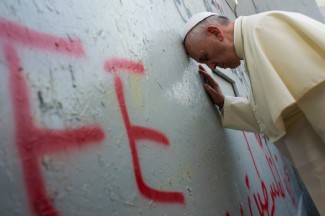
The prayer meeting, which the Vatican has been careful to note is not a prelude to formal peace talks, is the result of the pope’s recent trip to Jordan, Palestine, and Israel.
“We’re meeting to pray, only that,” the pope said, “and then everyone will go home.”
The pope’s trip was full of symbolic gestures that promoted peace and condemned violence on both sides. So of course, the prayer meeting is noteworthy because violence in the Middle East remains a tragic reality. If these three men, whose faiths have been at odds for centuries, can inspire others to join together and abstain from violence, the meeting will be a success.
And just as interesting, the meeting demonstrates how far the Catholic Church has come in how it approaches other faiths over the past 50 years.
The pope’s decision to bring two of his friends, one a Muslim and one a Jew, on his trip to the Holy Land was more than good optics. Seeing the three men embrace showed that religious differences need not lead to conflict and violence. Rather, we saw, religious differences can actually be a source of unity, especially in an increasingly secular West.
To readers of a certain age, it might seem unremarkable that a Catholic pope is so close to a Jewish rabbi, in this case, Rabbi Abraham Skorka, head of the Latin American Rabbinical Seminary in Buenos Aires and co-author with the pope of the book, On Heaven and Earth.
But it’s worth remembering that we’re just about 50 years out from the Holocaust. While many Catholic priests, nuns, and lay people acted heroically to save Jews, the Church, as a powerful European institution, failed one of its great moral tests.
In a new book, The Pope and Mussolini, Brown University historian David Kertzer examines the relationship between Pope Pius XI and the Italian dictator.
Kertzer argues that the small Jewish minority lived comfortably in Italy until Mussolini cozied up to Hitler. At that point, Mussolini clamped down on Rome’s Jewish community to bring Italy closer to Germany. Pope Pius XI had given up so much of the church’s autonomy to Mussolini that it was unable to resist the anti-Semitism spreading throughout Italy.
According to Kertzer, this turn of events worried Pius XI, but at that point, there was little he could do. Fascists attacked Catholic priests and laypeople, and Mussolini told Pius XI the attacks would only stop if the Church stayed out of politics. It appears, according to the book, that the Vatican accepted the offer.
Worse, Kertzer argues, the pope’s secretary of state, Cardinal Eugenio Pacelli, sympathized with German authorities and may have helped thwart an encyclical Pius had commissioned to condemn Nazi ideology.
Pacelli, elected pope upon Pius XI’s death, became Pope Pius XII, the subject of John Cornwell’s controversial book Hitler’s Pope. Pius XII’s supporters say that as pope, Pacelli provided false baptismal documents to many Jews to protect them from Nazi raids.
Others, however, see the Vatican’s unwillingness to speak out during the height of World War II as symptom of a deal between Hitler and Mussolini that guaranteed protection for the Church in exchange for its silence.
Some Catholics are eager to see Pope Pius XII made a saint, and given Pope Francis’ proclivity to canonize his predecessors, they see an opening.
But not so fast, the pope recently said during a press conference on his flight back to Rome from the Holy Land.
Perhaps recognizing the always-fragile state of Jewish-Catholic relations, Pope Francis said Pius XII’s canonization process has “stalled.” “The cause is open, I looked into it and no miracle has been found yet,” he said. “So the process has stalled. We have to respect the reality of this Cause. But there’s no miracle and at least one is required for beatification. I can’t think of whether I will beatify him or not.”
Over at the Boston Globe, John Allen notes that interfaith prayer, while still relatively new for Catholic popes, isn’t a novelty under Pope Francis.
“Jews and Muslims have their own sensitivities about praying with followers of other religions, while for Catholics, Pope John Paul II’s 1986 prayer summit in Assisi, Italy, the birthplace of St. Francis, opened a debate about the limits of interfaith prayer that has never really ended.
“It will be fascinating to see what kind of ritual organizers invent, and whether it includes joint prayer or rather separate prayers in the same space,” Allen writes.
Of course, praying for peace with representatives from two restive regions is a political act, no matter how much the pope tries to focus on the religious aspect. And there are plenty of issues that need prayer.
As with many of the pope’s headline-worthy events, the symbolism is often the most powerful aspect. Praying alongside a Jewish leader and a Muslim leader may have effects on relations in the Middle East. But it was also remind Catholics that other faiths are worthy of respect.